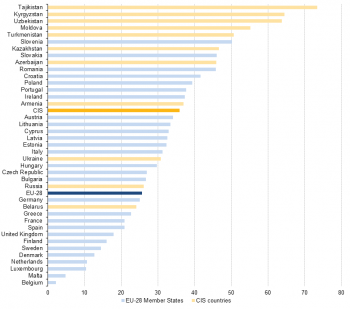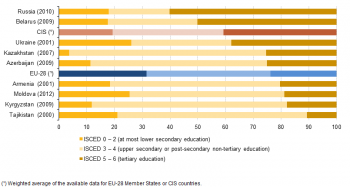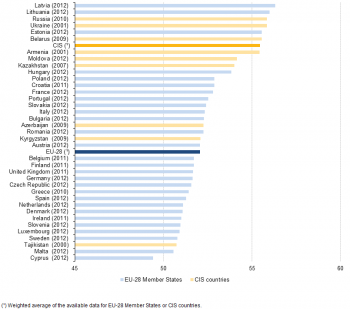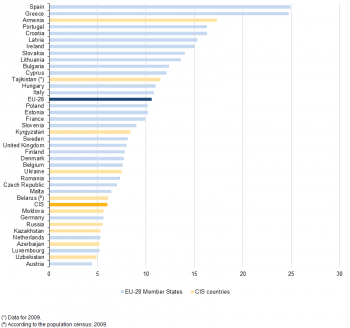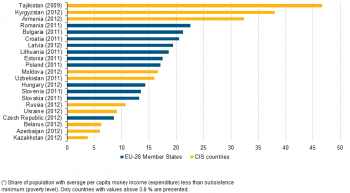Archive:EU-Commonwealth of Independent States (CIS) - statistics on population, employment and living conditions
This Statistics Explained article is outdated and has been archived - for recent articles on non-EU countries see here.
- Data extracted in August 2014. Most recent data: Further Eurostat information, Main tables and Database. No planned update.
This article is part of an online publication EU-Commonwealth of Independent States (CIS) - statistical overview (archived) and presents the latest data on the population of the countries of the Commonwealth of Independent States (CIS) and the EU-28 Member States, focusing on age distribution, educational level, economic activity and employment as well as living conditions.
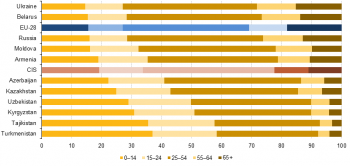
(%)
Source: Eurostat (nama_10_a10) and CIS-STAT
Main statistical findings
Population distribution of the CIS countries
Significant variations between Central Asian and European CIS countries
Figure 1 shows that in 2013, compared to the Central Asian CIS countries, the European CIS countries recorded considerably larger shares of the elderly (65+ years old) population and significantly smaller shares of the young (up to 24 years of age) population. Ukraine and Belarus had the largest share of elderly population (15.2 % and 13.8 % respectively), while the shares of the young population for Turkmenistan, Tajikistan and Kyrgyzstan exceeded 50 % (against less than 30 % in Russia, Ukraine and Belarus).
The share of the rural population in Central Asian CIS countries was significantly higher (73.4 % for Tajikistan, followed by 64.5 % for Kyrgyzstan and 63.8 % for Uzbekistan) than in European CIS countries (24.1 % for Belarus for instance), with the exception of Moldova (55.1 %). The share of the rural population in the EU-28 Member States (25.6 %) was smaller than the CIS average (35.9 %). However, Slovenia, Slovakia, Romania, Croatia, Poland, Portugal and Ireland had higher rates than the CIS average (Figure 2).
Although there are significant differences between the CIS countries and the EU-28 (both in age structure and share of rural population), Russia recorded similar figures to the EU-28 aggregates for both indicators. Given the demographic predominance of Russia (in 2013 Russia accounted for 51.2 % of the total CIS population—282 million persons), the overall difference between the CIS and EU-28 aggregates is reduced.
Further demographics and population dynamics
Higher crude birth ratios for Central Asian CIS countries, higher life expectancy for European CIS countries
Figure 3 shows that the Central Asian CIS countries and Azerbaijan recorded a higher crude birth rate and a lower crude death rate in 2012 than the CIS average (15.3 and 11.6 respectively), while the European CIS countries recorded an opposite pattern, except for Armenia for death rates.

(per 1 000 population)
Source: Eurostat (demo_gind) and CIS-STAT
The Central Asian CIS countries also had a significantly higher infant mortality rate than the European CIS countries and the EU-28 Member States (Figure 4). Turkmenistan, Tajikistan and Uzbekistan in particular recorded a high infant mortality rate (49, 45 and 34 deaths of infants per 1 000 live births in 2012, respectively) compared with the European CIS countries, and especially Belarus, which boasts a lower infant mortality rate than the EU-28 average (3.4 infant deaths 1 000 live births). With the exception of Romania (9.0), Bulgaria (7.8) and Latvia (6.3), the infant mortality rate in all EU-28 Member States was lower than 6 infant deaths per 1 000 live births in 2012.
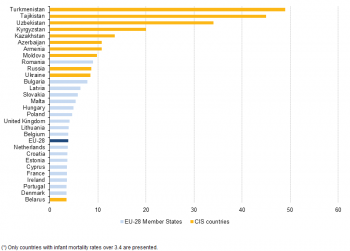
(deaths of infants aged under 1 year per 1 000 live births)
Source: Eurostat (demo_minfind) and CIS-STAT
Life expectancy at birth in 2012 was less than 75 years for all CIS countries, which was significantly lower than the EU-28 average (80.3 years). Armenia (74.3 years) was the only CIS country with a life expectancy at birth higher than any EU Member States (Lithuania and Latvia). Central Asian CIS countries, except Uzbekistan, had a life expectancy at birth of less than 70 years (Figure5).
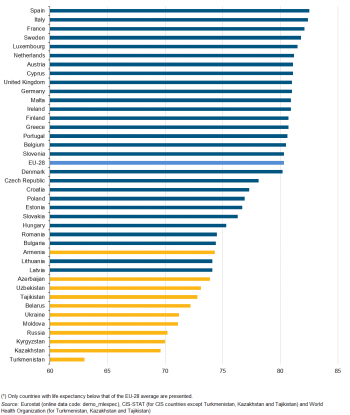
(in years)
Source: Eurostat (demo_mlexpec), CIS-STAT (for CIS countries except Turkmenistan, Kazakhstan and Tajikistan) and World Health Organization (for Turkmenistan, Kazakhstan and Tajikistan)
Educational level and tertiary education
CIS countries have a higher level of educational attainment than EU-28 Member States
Figure 6 shows that over 40 % of the total CIS population aged 25 or older had a tertiary education degree (ISCED 5–6) while the EU-28 average was significantly lower (23.8 %). Variations among CIS countries were notable, with shares of tertiary education graduates varying from 10.6 % (Tajikistan, 2000) to 60.1 % (Russia, 2010).
The share of post-secondary non-tertiary education (ISCED 4) graduates in Moldova, Armenia and Kazakhstan was considerably higher than in Azerbaijan or Russia.
The top 3 CIS countries in terms of share of tertiary education graduates corresponded to the countries with the greatest shares of women with tertiary education: Russia, Ukraine (both 55.8 %) and Belarus (55.5 %) (Figure 7). The CIS average stood at 55.5 %, which was more than the EU-28 average (52 %). The share of women in tertiary education in the CIS countries was generally larger than in the EU-28 Member States, even though Tajikistan had the third lowest share among all the countries considered (50.7 %), only ahead of Malta (50.6 %) and Cyprus (49.4 %). Significant variations among CIS countries reflect differences in national educational systems and labour market conditions.
Employment and unemployment
High unemployment in Armenia and Tajikistan
Kazakhstan and Russia recorded the highest activity rates (71.7 % and 68.7 % respectively) and employment rates (67.9 % and 64.9 % respectively) among CIS countries, while Moldova and Tajikistan both had activity and employment rates of less than 50 % (Figure 8).
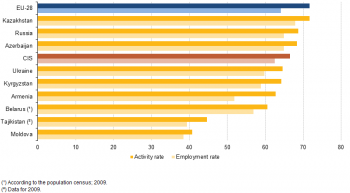
(%)
Source: Eurostat (lfsi_act_a), (lfsi_emp_a) and CIS-STAT
Figure 9 shows considerable differences between CIS countries in terms of the distribution of employment by sector of economic activity. Russia (27.8 %) and Belarus (according to the population census 2009) (33.7 %) recorded the largest shares of employment in industry (including construction, NACE rev. 1.1 codes C–F). Tajikistan (2009, NACE rev. 1.1 codes A–B) (52.9 %), Azerbaijan (37.7 %) and Armenia (37.3 %) on the other hand relied heavily on the primary sector (NACE rev. 2 code A). Ukraine had a services-oriented (NACE rev. 1.1 codes G–Q) economy, (62.1 %), second only to Russia (64.9 %).
The share of employment in the primary sector in the CIS countries was larger than the EU-28 average by 9.9 percentage points (14.9 % and 5.0 % respectively), while the share of employment in the tertiary (services) sector was smaller in the CIS countries (60.4 % against 70.3 % in the EU-28).
EU-28 Member States generally recorded a higher unemployment rate than the CIS average (Figure 10). Germany, Austria, Luxembourg and the Netherlands were the only EU-28 Member States with an unemployment rate lower than the CIS average (6.0 % in 2012), while Armenia (17.3 %) and Tajikistan (11.5 % in 2009) were the only CIS countries with unemployment rates over the EU-28 average (10.6 %).
As far as the youth unemployment rate is concerned (Figure 11), Armenia stood out with 35.4 %, while the CIS average was 14.5 %. Kazakhstan recorded a very low youth unemployment rate of 3.9 %, while the youth unemployment rate in all other CIS countries (except Armenia) was lower than that of most EU-28 Member States (except Germany, Austria, the Netherlands, Denmark and Malta).

(%)
Source: Eurostat (une_rt_a) and CIS-STAT
Income and living standards
Highest poverty headcount ratio in Tajikistan, highest income inequality level in Russia
Figure 12 shows that a considerable share of the population of Tajikistan (46.7 %), Kyrgyzstan (38.0 %) and Armenia (32.4 %) lived below the national poverty line, while the corresponding shares for Kazakhstan (3.8 %), Azerbaijan (6.0 %) and Belarus (6.3 %) were significantly lower. Some EU-28 Member States also recorded considerably high shares (greater than 20 % in Bulgaria, Croatia and Latvia).
Income inequality is commonly measured through the Gini coefficient, which is a measure of statistical dispersion intended to represent the income distribution of a nation’s residents. The coefficient varies between 0, which reflects complete equality and 100, which indicates complete inequality (one person has all the income or consumption, all others have none). Figure 13 shows that Kyrgyzstan and Russia recorded the highest levels of income inequality (42.0 in 2012) among CIS countries. The levels of income equality of Ukraine (24.8), Kazakhstan (28.4) and Belarus (28.5) were lower than the EU-28 average (30.6) in 2012. Even though the income inequality level in Azerbaijan (33.0 in 2008) was relatively high, it was still lower than that of certain EU-28 Member States (Latvia, Spain, Portugal, Greece, Bulgaria and Romania).
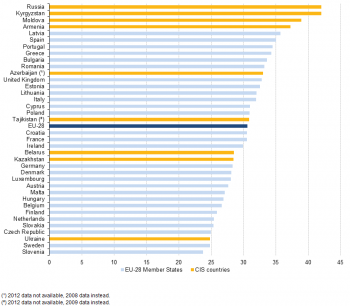
(Gini coefficient)
Source: Eurostat (ilc_di12) and World Bank (for CIS countries)
Data sources and availability
All data used in this publication are provided by CIS-STAT (latest annual data per indicator presented), except for the data mentioned below.
Education data stem from the UNESCO web database (UIS.Stat). The reference year corresponds to the latest data available by country. No data are available for Turkmenistan and Uzbekistan.
EU-28 data used for the study of the age distribution of the population and the population dynamics (Crude birth ratio/crude death ratio, infant mortality rate and life expectancy) stem from Eurostat (available on annual basis).
EU-28 data on economic activity, employment and unemployment also stem from Eurostat, except for data on employment by economic activity sector which stem from the OECD web database. All employment data originate from EU-LFS (available on annual and quarterly bases, only annual data were used in this publication). The same data are also provided by the ILO.
The data used for the study of the rural population, the Gini coefficients used for the study of income inequality and the poverty headcount ratio at national poverty line for certain EU-28 members stem from the World Bank web database (available on annual basis).
Missing data on population dynamics for CIS countries were filled in by (annual) data from the World Health Organization (Global Health Observatory Data Repository).
Methodology / Metadata
Rural population refers to people living in rural areas as defined by national statistical offices. It is calculated as the difference between total population and urban population.
For further reading regarding the fertility and mortality indicators included in the publication, metadata are available in ESMS form (demo_fer_esms and demo_mor_esms respectively).
UNESCO education data use the ISCED-97 classification for education levels. EU-28 and CIS aggregates and averages were calculated from the most recent data available for their respective member states. No data are available for Turkmenistan and Uzbekistan.
CIS-STAT labour market data are comparable to the data selected as part of the EU-LFS. Metadata on employment and unemployment are available in ESMS form (employ_esms). The NACE rev. 2 classification is used for the categorisation of sector of economic activity for all countries except Belarus, Moldova, Russia, Tajikistan and Ukraine for which NACE rev. 1.1 classification is used instead.
Detailed definitions and calculation information on the Poverty headcount ratio at national poverty line and the Gini index for income inequality are provided by the World Bank.
Data provided by different sources are comparable at indicator/figure level.
Context
The CIS countries present significant differences in terms of population structure and dynamics, educational level, employment and living conditions among themselves and compared to EU-28 Member States. Russia (accounting for the 51.2 % of the CIS population) has a large share of tertiary education graduates (60.1 % of the total population aged 25+), a large economic activity rate (68.7 %, second only to Kazakhstan), but also high income inequality (on par with Kyrgyzstan) (Gini coefficient = 42.0) compared to the EU-28 average.
See also
- European Neighbourhood Policy - East - population statistics
- European Neighbourhood Policy - East - labour market statistics
- The EU in the world - population
- The EU in the world - education and training
- The EU in the world - labour market
- The EU in the world - living conditions
Further Eurostat information
Data visualisation
Main tables
- Population on 1 January (tps00001)
Database
- Population on 1 January by age and sex (demo_pjan)
- Population on 1 January by five years age group and sex (demo_pjangroup)
- Demography and Migration
- Population change — Demographic balance and crude rates at national level (demo_gind)
- Population (demo_pop)
- Population on 1 January by five years age group and sex (demo_pjangroup)
- Mortality (demo_mor)
- Infant mortality rates (demo_minfind)
- Life expectancy by age, sex and educational attainment (demo_mlexpecedu)
- LFS main indicators (lfs_act)
- Population, activity and inactivity — annual averages (lfsi_act_a)
- Employment — LFS adjusted series (lfsi_emp_a)
- Employment (main characteristics and rates — annual averages (lfsi_emp_a)
- Unemployment — LFS adjusted series (une)
- Unemployment rate by sex and age groups — annual average, % (une_rt_a)
Dedicated section
Source data for tables and figures (MS Excel)
External links
- Interstate Statistical Committee of the CIS
- ISCED-97 classification
- NACE rev. 2 classification
- NACE rev. 1.1 classification
- World Bank
- Global Health Observatory Data Repository
- UNESCO web database (UIS.Stat)
- OECD web database
- International Labour Organization (ILO)
